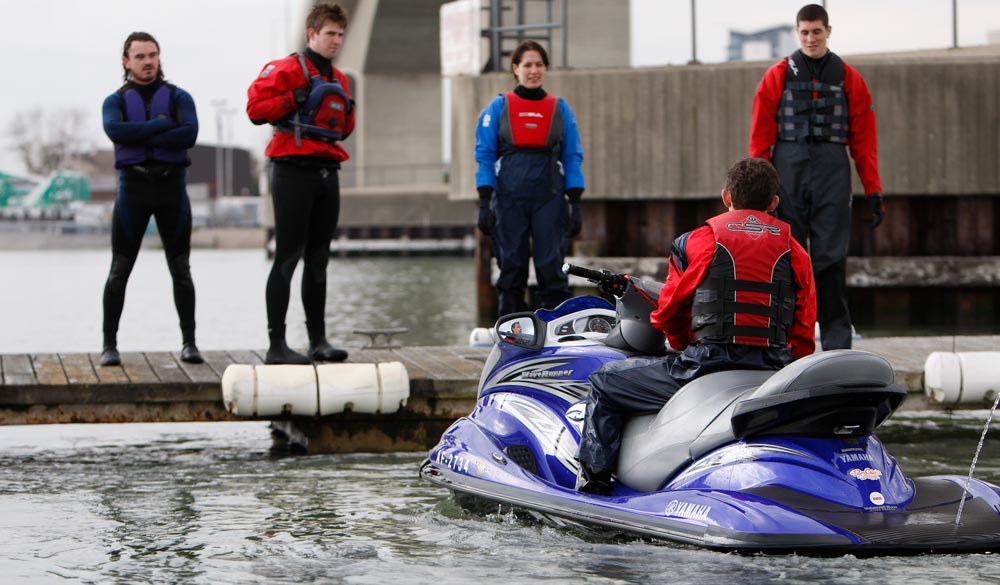Personal watercraft safety
Riding a personal watercraft (PWC) is a great way enjoy the water
Riding responsibly
Personal watercrafts, commonly referred to as jet skis, have evolved from niche vehicles to one of the most popular crafts on UK waters. While the thrill factor is high, the risks associated with a PWC should not be ignored.
Before riding your PWC, here are a few key things to remember:
- Do your research regarding local regulations and licensing requirements.
- Check the forecast and tides.Have a plan for where you’re going and never ride solo.
- Carry the right gear and a means to call for help.
- Stick to speed limits and stay out of exclusion zones.
- Respect others, both on and off the water.
- Respect the Marine Code to help protect marine life.
- Always let a friend or family member know where you’re going and when you’re back on shore. Consider using the free RYA SafeTrx app to help with this.
Get trained
Modern jet skis can reach speeds in excess of 60mph, in the blink of an eye. Because of this, it's essential to have a solid foundation of knowledge to help you safely operate your personal watercraft.
The RYA Personal Watercraft Proficiency course offers an affordable, one-day training course, teaching you how to ride responsibly. You’ll cover the basic skills of navigation and ‘rules of the road’, including knowing what buoyage signifies and how to avoid collisions.
Anyone who takes the course will be provided with a copy of the RYA Personal Watercraft Handbook (G35). This instructional handbook is essential reading for both novice and experienced PWC riders. Packed with information and advice, it features everything from pre-launch checks and passage planning to offshore cruising and legal requirements.
As you progress in your PWC adventures, other RYA courses are available to further increase your skill set, include the RYA Marine Radio Short Range Certificate (SRC) course, or one of the navigation courses.
PWC safety in emergencies

The safest way to operate a PWC is with the company of another craft, so that help is readily available in emergencies. However, additional steps should be taken to ensure safety your safety on the water, such as:
Life jacket or buoyancy aid – that’s the appropriate size for your body and weight.
Killcord – Always use the kill cord and ensure it is attached to you. It is also advisable to carry a spare.
Location – Always ensure you ride in a PWC approved location.
VHF – A marine band VHF radio will allow you to speak with the coast guard and other crafts at sea. You will need a VHF operator’s licence and licence for your radio.
Flares – If you are in grave danger do not hesitate to use flares to signal for help. In bright daylight orange flares are the most effective signal. In overcast conditions a red hand-help flare should be used. Always store flares in a water-resistant container.
Mobile phone – Keep it in a waterproof pouch. Check your battery is fully charged before departure and remember that you may find ‘dead spots’ with no coverage when at sea. You can contact the Coastguard by dialling 999 or 112.
Bag Anchor / Anchor – A bag anchor can be used as an effective sea drogue in an emergency. The most common type of anchors used on PWC’s are grapnel and danforth, which fold for easy storage.
Protect and promote safe riding

Some busy commercial harbours have designated channels to keep small craft out of the way of shipping. Others may ban them altogether or offer a dedicated PWC zone. Before setting out on the water always ensure that you check and abide by local regulations.
Unfortunately, there isn’t a national scheme in operation, so you may need to pay for additional registrations to launch in some areas. Many local councils also set minimum rider ages and require RYA qualifications to ride in the area.
The RYA has been working with the PWP to improve welcome signage at launch sites. This initiative is designed to promote the safe riding of personal watercrafts or jet skis at popular locations.
Signage is available for free to harbour authorities and launch sites around the UK. Its graphics clearly welcome PWC users to the area whilst providing a reminder for safe and considerate riding.
To order a copy of the new signage or for additional resources, visit the PWP.
